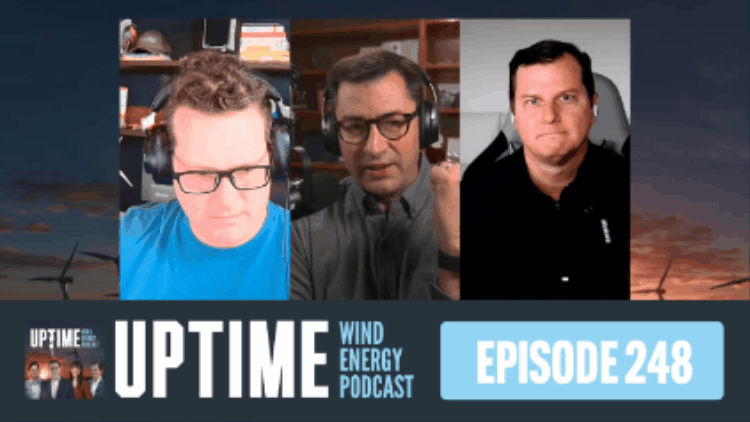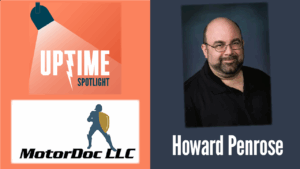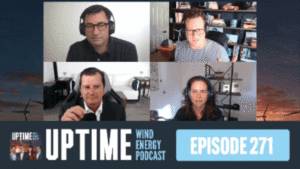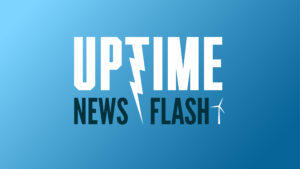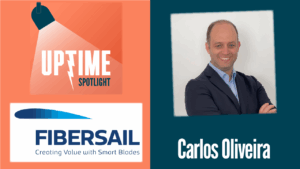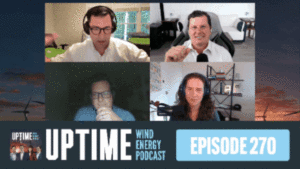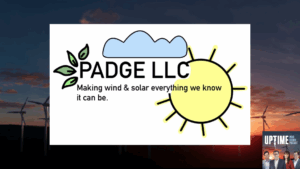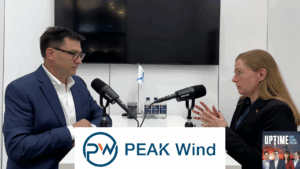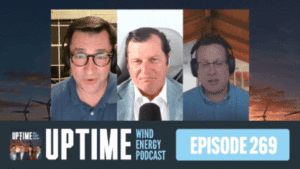Podcast: Play in new window | Download
Allen, Joel, and Phil discuss the growing popularity of return-to-office mandates. New York state has signed a climate change superfund act, making companies pay for pollution retroactively. And Dominion Energy’s Coastal Virginia Offshore Wind Project should be successfully finished in 2026.
Fill out our Uptime listener survey and enter to win an Uptime mug! Register for Wind Energy O&M Australia! https://www.windaustralia.com
Sign up now for Uptime Tech News, our weekly email update on all things wind technology. This episode is sponsored by Weather Guard Lightning Tech. Learn more about Weather Guard’s StrikeTape Wind Turbine LPS retrofit. Follow the show on Facebook, YouTube, Twitter, Linkedin and visit Weather Guard on the web. And subscribe to Rosemary Barnes’ YouTube channel here. Have a question we can answer on the show? Email us!
Pardalote Consulting – https://www.pardaloteconsulting.com
Weather Guard Lightning Tech – www.weatherguardwind.com
Intelstor – https://www.intelstor.com
Allen Hall: Newark launches a landmark challenge to Big Energy. Dominion Energy proves offshore wind can work in America and the great return to office debate hits the wind industry. All this, plus much more. You’re listening to the Uptime Wind Energy Podcast. You’re listening to the Uptime Wind Energy Podcast brought to you by buildturbines.com.
Learn, train, and be a part of the clean energy revolution. Visit BuildTurbines. com today. Now here’s your hosts, Allen Hall, Joel Saxum, Phil Totaro, and Rosemary Barnes.
Allen Hall: Hey Uptime community, want to help shape the future of your favorite wind energy podcast? Take our quick 5 minute survey at UptimeWindEnergy.com
com for a chance to win an exclusive Your insights matter to us, whether you’re a long time listener or just joined us. Please go to uptimewindenergy. com and complete the survey. We would appreciate it. And then, if you haven’t registered for Wind Energy O& M Australia, now’s the time to get on that because we’re gonna have a great time down in Melbourne, and we’ll be with bunch of industry leaders on February 11th and 12th in Melbourne.
It’s a great time to discuss leading edge erosion, lightning protection, life extension, CMS, all the things that we talk about all over the world. We’re going to focus on the Australian market and we’ll have industry experts from our own Sky Specs, Tilt Renewables, GE, Vernova, RigCom, Whirly, Eelogix, Ping and many more.
So reserve your spot now by visiting www. WindAustralia. com. It’s time to transform your safety program at Active Training Team’s Free Houston Expo on January 24th. Experience the innovative training methods that are revolutionizing the energy sector. And let’s face it, the era of laptop training is over.
Is Dead Active training team uses real actors live humans on site to place your team members in real world situations. Now there’s limited spots available. And to secure your spot, you need to go to active Training team.us/contact, or email florence@activetrainingteam.co.
Unlock your wind farm’s best performance at Wind Energy O& M Australia, February 11th to 12th in sunny Melbourne.
Join industry leaders as they share practical solutions for maintenance, OEM relations and asset management. Discover strategies to cut costs, keep your assets running smoothly and drive long term success in today’s competitive market. Register today and explore sponsorships at www. windaustralia.com.
Allen Hall: All right. 2025 is going to be an exciting year for the return to office. Now, a lot of companies are mandating the return to office, but the attendance hasn’t been so great. The. Office attendance reached about 62 percent at pre pandemic levels, according to Betty. And it’s planned to increase to almost 70%.
So there’s 30 percent of society that hasn’t really returned to office. Now, as we have seen on X and on With Amazon and a number of other tech companies, they are really pushing for it to get back in the office, and they’ve seen about an 11 percent rise in office attendance, and it is becoming mandated.
So Amazon is requiring three days and plans to reach five days during 2025. Apple requires Tuesdays and Thursdays, plus one team day in the office. And Disney’s mandated four days. Minimum on site, but in the wind industry, we’re haven’t really seen that yet. There’s a lot of offices, Joel, you and I have been to it over the last six months or so.
Which are still pretty empty.
Joel Saxum: Yeah, absolutely. I think it’s the nature of the work too, right? Wind is distributed, right? It’s all over the place. So when you’re saying, Hey, I’d love to go talk to, this team of engineers. In general, that team of engineers is spread all over the country anyways.
You may have one in Chicago and one in Houston and one in. wherever South Carolina or whatnot. So you don’t it’s an odd thing, but I think in the grand scheme of things, the wind industry does remote work pretty well. Just because we’ve always had to do it, right? You’re always if you’re a back office engineer, or if you’re an asset manager, if you’re in procurement, you’ve always been dealing with remote sites since wind has been a thing, so it’s not something that’s crazy new for us to do well.
The other side of it is, I think that this is a personal thing from business wise. I’m not 100 percent opposed to the back in office thing. I don’t like the idea of mandate four or five days a week, but I think there is value that you get out of sitting face to face with team members that you just can’t get over teams.
And I think that extends to a lot of things in business. Right now I talk with salespeople all the time, sales and revenue generation and client facing and it’s almost like in some respects. People have forgot how to do that part of business in person. If that, does that, does that make sense?
Phil, have you seen that in your BD activities?
Phil Totaro: Yeah. The reality of it is that people would still rather shake hands than, as a way to, to close a business deal than, do it remotely. It’s pretty rare to do a big deal having never met face to face including from my own company but even from my experience.
Before the pandemic, we had an office in Houston, and it was, it wasn’t necessarily mandatory to come into the office all the time, but it was a good idea to get people to, to come together. Since the pandemic, I’ve allowed everyone to work remotely, because frankly, I work remotely too, for the last 14 or 15 years since I started the company, because prior to the pandemic, I was traveling all the time as well.
Business development reasons. And my own philosophy on it is look, you’re even though all my employees are contract employees, the reality of it is they’re also, on salary, they are not chained to a desk nine to five. The idea is you get your job done and you get your compensation for doing the, helping us achieve the goals and objectives as the company.
And the reality of that is that if you can work from the beach, I don’t care, but if you don’t get your job done, you’re out. And that’s, that sounds harsh, but that’s just the reality of how we’ve done things. It’s a new version of leadership.
Allen Hall: It is a new version of leadership.
And the thing about the wind industry is there’s so much of the technician side, which has to be on site and has to be there every day and has to put in that 40 plus hours a week. And then when you get to the sort of the front office people, they seem to have dispersed a little bit. I don’t know how that culture works internally.
I’m actually a little concerned for some of the companies because the technician side has to be a little bit upset with this. It’s Hey, when I need. That engineer, I really need that person to be here. If they’re not in the office, that can be a little bit difficult. I would see those conflicts really arising this year in particular.
Phil Totaro: It’s possible because, but what’s also interesting about it is that there’s a lot of companies and you mentioned active training team in the intro, Alan, that a lot of companies are trying to leverage. More technology to enable onsite technicians to do their job more efficiently, including you could have somebody leveraging, remote inspection technology that then goes back to an office for an engineer to review it, then that, the end result of that analysis goes back out in the field to tell the technician what to do.
And so there’s a whole chain that, that has to be doing their job. But again my point, is, and I take what Joel’s saying here, but my point is that it doesn’t really matter where they are when they perform their job function as long as they’re doing it to make sure that they’re not the weak link in that chain for, making sure assets perform to a, to an operationally sound level.
Allen Hall: Joel, do you think you’ll see people leave? Companies this year because they’re forced back in the office.
Joel Saxum: Yeah, I think the really important thing to consider here is exactly what you’re saying Alan is this is a this will be Whether it’s to what’s supposed to be temporary or will be permanent or whatever.
This is a cultural change within a company this is a change management thing that needs to be handled very well. And if it’s not handled properly some companies are using it as a tool to flush people. They’re like we’ve got 2000 people. We’re going to mandate it back to office.
And you got part of them just saying we’re not coming. Okay, cool. Then you’re released. All right. Now we’re down to, 1800 employees that we have to pay. So it’s a tactic that’s being used to force people out. But I just think that if you’re. So take this note, if you’re a person that’s in charge of this mandate or in charge of making sure this mandate goes well, whether you’re in HR or whatever, make sure you have a good plan and it’s been spot through and you understand what’s going to happen because you probably will lose some people if you’re going to force this and just make sure that the transition back to an in office thing goes well because if it’s done poorly, I think it can have big reverberations around any company.
Allen Hall: And Phil, middle management has been getting decimated over the last two or three years since COVID. It’s a really hard thing to manage if everybody is off site all the time and you’re trying to run this organization, you’re being held accountable for numbers, in particular, and schedule dates that if you got people all over the place, it does make it hard to get that momentum built up, doesn’t it?
Phil Totaro: Yeah, that’s a good point. And I think that, with what we’ve been talking about with, a return to office and be the how it’s applicable to the wind industry. I think in a larger company in general, it might be more important for people to be. Not necessarily back in an office at all times, but what Joel was mentioning, to have that face to face collaboration more frequently than it, it is necessarily for a smaller, more nimble company.
Because it just depends on, how quickly you need to be able to react and whether or not everybody’s bought into the vision for what you’re trying to achieve, whether it’s your corporate goals at the top level the middle management level where they have to get, the people with boots on the ground to, execute.
That’s where the rubber meets the road. Almost literally. When you talk about getting You know these corporate objectives executed on, you need to have everybody on the same page being able to do that. And in a, if you want to manage your smaller team in a way where, some people can work remote, As long as you’re making it happen, that’s fine, but as you mentioned, Alan, people are responsible for hitting their numbers, and if they’re not doing it, then they are going to be on the chopping block.
Allen Hall: If there’s a number of people that still want to work from home, which I think that there are, how are they going to do it? Are they looking to get into another industry? Are they looking to become consultants? Are they looking to change their job description where they can do this? How do they remain remote?
When there’s going to be a big pull to get them back in the office.
Joel Saxum: I think you’ll see a lot of that. The future, I believe that the future of work is consultants. Specialists that can work for multiple people and do certain things. And I think that’s what we’ve seen with the layoffs at GELM, all the other things.
We’ve seen a lot of independent consultants pop up because it gives people more control over their, their day to day, their future, their, whatever they want to, whatever they want to do. So I think that you may see some people do this. The other one is when you hire on this is a, thing from within my family household, when you hire on, if you want to be remote, make sure that it says remote worker in your job offer, because then if they try to come back at a later date and say, you have to return to office, say I signed a contract that says I’m a remote worker.
Allen Hall: Yeah. Still doesn’t mean they can’t cancel your contract, but I do think that does help to clarify the situation because a lot of times people have gone remote. Just because of situations family issues, whatever, and they end up staying remote and it does create this little conflict at the end where management’s saying, Hey, you were in the office six months ago.
I really need you back here because we’ve got these big projects we’re supposed to finish. Gonna need people here. And that’s, I think, where the conflict really begins to become escalated. As wind energy professionals, staying informed is crucial, and let’s face it, difficult. That’s why the Uptime Podcast recommends PES Wind magazine.
PES Wind offers a diverse range of in depth articles and expert insights that dive into the most pressing issues facing our energy future. Whether you’re an industry veteran or new to wind, PES Wind has the high quality content you need. Don’t miss out. Visit PESWind. com today. There’s been two big news articles coming out of New York State.
The first is Governor Hochul has signed a 75 billion climate change superfund act requiring large oil and gas companies to pay for climate resilience projects across the state. Now this, New law targets companies that have emitted over 1 billion metric tons of greenhouse gases between 2000 and 2018.
The Department of Environmental Conservation will oversee the implementation, identifying the highest emitters, and managing payment collections. And this is coupled to a couple of the things that are happening in your state, the second being that they’re blocking the northern access gas pipeline, which was a 500 million project that was running from Pennsylvania towards the Midwest and part of it went through Western New York and New York doesn’t want it.
So it’s canceling that project. It’s about 1, 600 construction jobs and tax revenue for rural counties. Now Joel, New York State is putting itself in a real bind here if they’re going to hit oil and gas companies with a 75 billion tax, and then cutting off oil and gas exploration, which they’re doing, have done for a number of years, and renewables are not really backing up their electricity grid and their power infrastructure.
Where is New York headed?
Joel Saxum: I think this is a classic case to me of biting the hand that feeds if you will oil and gas industry. First off. Like I address the $75 billion initiative in this New York Climate Change Super Fund Act. How you’re going to tell each of these companies what they actually produced in greenhouse gases between 2000 and 2018.
And then basically fining them for something that they did in the past that was not legislated when it happened. I don’t know how you’re gonna manage any of this. The first thing I see is some other circuit court judge striking this down, or the first time that the state of New York tries to send Exxon Mobil an initial, a bill of 200 plus million dollars.
Exxon’s gonna laugh, first off, and then they’re gonna send their lawyers to Albany to fix this. Because I think that one of the things in New York is New York City and Albany may want things, but New York as a state Is not the same. There’s a lot of great do gooding for the climate, which I’m all for.
However, you need to have a backup plan. And what I see for them now is rolling brownouts or blackouts in the future because they don’t have a backup plan for their
Phil Totaro: energy. This is what happened in California in 2004 and led to the governor being ousted. Because they didn’t, they just didn’t plan ahead with their, it wasn’t triggered by them mandating a super fund and all that sort of thing, but they didn’t invest enough in the energy infrastructure to the point where they could avoid the rolling brownouts and blackouts.
And people got so mad about it that they just got rid of who was it, Gray Davis? As governor. I can see why they’re putting something in place that would necessarily go and look back on the amount of emissions. By the way, Joel, they can’t measure how much the emissions that they produced they can measure NOx and SOx emissions out of the different plants and stuff like that.
So there are ways of monitoring how much was produced and that’s not likely to be the subject of debate. What is the other thing you mentioned, which is, why am I being taxed on something that I wasn’t being, regulated on before or taxed on before? If you’re going to implement a new, yeah, if you’re going to implement something new, make it from today forward, not retroactively back, to the year 2000, when I, I would have run my plant differently if I knew I was going to be taxed for it later.
It’s just a preposterous approach.
Allen Hall: I guess it comes back to my question. Can you tax a company for something they did outside of your state like that? How does that work? You can say there’s carbon dioxide in the air, sure, but there’s carbon dioxide everywhere.
How much do you associate with a particular oil company? I know you can quasi measure that, Phil. But realistically, are you going to do this to a Saudi based company? How does this work? Where are you going to send the bill?
Phil Totaro: Let’s also take the example of when Spain tried to apply retroactive taxes on wind farms.
It caused absolute chaos over there and for years, nobody wanted to even build new wind farms, let alone operate the old ones that, that they had and it’s what caused a lot of these, wind farms in Spain to become so decrepit at this point.
Joel Saxum: But I think that’s what New York State is doing, so this, let’s set this one as an example.
But New York State right now, if you watch what they’re doing to Taxes and different things. Like it’s becoming a state that you don’t want to do business in. Like I, I wouldn’t you’d never find, unless I had to be in New York city for something, I wouldn’t, set up a company there because of the tax laws and the problems, it’s the same thing.
Like the Cook County, the city of Chicago, where the taxes are so much higher than all the surrounding areas. Like I wouldn’t do business there. That’s crazy. So what they’re going to end up doing by trying to implement all these things is they’re just going to drive business away because they’re on, basically, this is untrustworthy.
This thing to me is,
Allen Hall: yeah, you can’t plan ahead in New York right now. If you’re a business, it makes it really hard because the energy prices are just going to skyrocket when you start doing this, that’s an inevitable outcome of this dealing with damaged blades. Don’t let slower pairs. Keep your turbines down.
Blade platforms get you back up and running fast. Blade Platform’s truck mounted platforms reach up to 100 meters, allowing for a quick setup, improved safety, and efficient repairs. Book soon to secure your spot and experience a difference in blade access, speed, and efficiency. Visit bladeplatforms. com and get started today.
I want to move on to something that is successful, which is Dominion Energy’s Coastal Virginia Offshore Wind Project, which is half way. Mark in construction, and remember that’s a 176 Siemens Gamesa turbine off the coast of Virginia, which is supposed to complete in late 2026. And as far as I can tell, and I’ve been watching this pretty closely over the last several months.
At least the installations and all the deployments and all the activity has gone relatively smoothly compared to some other projects in the U. S. I would assume that’s just because of the massive effort and the planning that went into it ahead of time. To get this thing right, Phil, right?
Phil Totaro: We’ve talked on the show before about like, why is Dominion just smooth sailing while everybody else is having all these problems? And a couple of things come to mind about it. Number one, Dominion’s already the, utility in Virginia that is off taking the power so they don’t have to haggle with the utility companies or the state or whatever, some state regulator.
about how to structure the PPA and how much to pay for it, this, that, and whatever. They’re off taking the power and selling it to, utility customers whether it’s commercial or residential. And making whatever margin they can make on, the generation cost versus the ultimate sale price.
The second thing is that Dominion, remember, budgeted, I think it was 9. 8 billion for this project, which is frankly a rather large amount of money. And yes, that does include their transmission infrastructure and everything too. But they’ve got plenty of what do you call it?
Management reserve. In there in case they run into any problems which they frankly haven’t as far as the installation and construction goes they’re I think just a fraction over 50 percent done with the the foundations now. They paused for the winter and they’re going to resume in the spring.
I think the only thing I’ve heard of that was any kind of a complaint was some of the locals complaining about some of the noise from the monopile driving. But, the thing is so far offshore that I’m not even sure really how anybody can complain about that. This looks like it’s going to be probably one of the better run projects not only in the United States, but potentially in the world.
Joel Saxum: I think the big thing there that you touched on, Phil, is just a reduction of stakeholders. Yeah. Too many cooks in the kitchen. Exactly. There’s not there’s just a few really good cooks and they’re getting it done quietly down there for this coastal Virginia offshore wind farm. And I think that’s the big part.
It’s difficult to pull off a large capital project, and it doesn’t matter what it is. Whether it’s a freaking football stadium, a bridge, a highway, an offshore wind farm, whatever, it doesn’t matter what it is. It’s difficult when you have a lot of stakeholders, but when you reduce that down to the number of decision makers can get things through the pipeline quicker, and you can make operational decisions quicker, this is the result you have.
Allen Hall: They’re expected to save their customers 3 billion in fuel costs over the first decade of operation. And it’s going to serve like 25 percent of their residential customers. This is a huge project for them. And it’s going really well, so congratulations to Dominion Energy. It’s remarkable. And let’s close this project out
Joel Saxum: with success.
The Wind Farm of the Week this week is the Karankawa Wind Farm by Avangrid Renewables down in Texas. The project reached Commercial operation in December of 2019. And it is a mix of 124 GE turbines from 2. 3 to 2. 5, two. So if you’re in the wind industry, these is the one 16 meter rotors and the one 27 meter rotors.
Some interesting things it’s doing down there in Texas is they. Make sure that they looked after the whooping cranes. If you’re been along the South Texas coastline, that kind of intermediate area between the ocean and the protection islands and the marshes is a very sensitive ecosystem. This wind farm being just outside of that, they took care of the whooping cranes in the area as, By burying all of the electrical cable that was used on site.
So instead of leaving power lines up above ground, they buried every single one of them over 90 miles of electrical lines within this wind farm to protect for those wind farms. Or to peck for those whooping cranes. So the interesting thing here, after achieving commercial operation, the facility has 12 full time employees and it will provide over 125 million in taxes and over 3 million annually, that is.
Supporting schools, public health, fire, library, and other public services in the area. So the Karankawa Wind Farm by Avon Grid Renewables down there in South Central Texas, you are the wind farm of the week. That’s going to do it for
Allen Hall: this week’s Uptime Wind Energy podcast. Thanks for listening and please give us a five star rating on your podcast platform.
And subscribe to our substack, Uptime Tech News, our weekly newsletter. And we’ll see you here next week on the Uptime Wind Energy Podcast.



